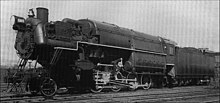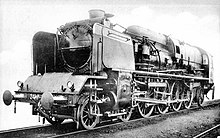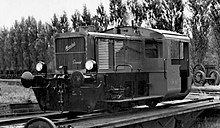High pressure locomotive

High- pressure locomotives , also called high-pressure steam locomotives , are steam locomotives that were operated with a boiler pressure of over 25 bar. Of this special design, 24 locomotives were built between 1925 and 1954 worldwide for test purposes. The complicated technology promised better efficiency, but was only developed slowly because of the Great Depression and the Second World War , until it was overtaken by the introduction of electric and diesel locomotives .
technology
Locomotives with classic steam locomotive boilers according to Stephenson have technical and economic limits because the boiler pressure cannot be increased above 21 bar without disadvantages. Because as the boiler pressure increases, so do the demands on the boiler building material, so that manufacturing and maintenance costs rise. The overall efficiency of such a locomotive is 10%. It was known from ship steam engines and stationary systems that higher steam pressures save both fuel and water. In addition, smaller cylinders can be used and the steam can be expanded not only in two, but also in three stages, as in the case of conventional composite steam locomotives . However, these advantages had to be bought at the cost of a different type of boiler, the water tube boiler , which was more complicated in construction than the Stephenson boiler and had not yet proven itself in rail operations. In addition, an induced draft system usually had to be used to fan the combustion.
Boiler types
Schmidt-Henschel boiler
The two-pressure boiler or Schmidt-Hartmann boiler developed by the Schmidtsche Superheated Steam Company consists of a closed high-pressure circuit that heats an open low-pressure circuit via a heat exchanger. The evaporation thus takes place outside the furnace, where the pipes are not directly exposed to the radiant heat. This prevented unclean water from forming scale in the pipes. The only deposits were on the outside of the tubes of the primary circuit in the evaporator drum, where they were easy to clean. The primary circuit was filled with purified water so that no deposits could arise there.
In collaboration with Henschel, the Schmidt boiler was adapted for installation in locomotives. The primary circuit of the Schmidt boiler had the highest pressure of 95 bar, the high-pressure steam generated in the secondary circuit had a pressure of 60 bar. Preheater and heating pipes of the primary circuit formed the walls of the fire box . This was followed by a conventional long boiler in which superheated steam was generated at a pressure of 17 bar. The steam from the Schmidt boiler was fed to the individual high-pressure cylinder in the frame. The exhaust steam from this cylinder got into the two outer low-pressure cylinders together with live steam from the long boiler.
Several locomotives were equipped according to the Schmidt-Henschel system, including the H 17 206 . The locomotive was used on test drives with a measuring car. A theoretical fuel saving of 47 percent was hoped for. However, the actual values were much lower and did not justify the high development costs. In addition, there were safety concerns due to the high steam pressure when driving. The necessary maintenance work and the associated costs were not clarified.
Mill field water tube fire tube boiler

The German-born engineer John Erhardt Mühlfeld designed a boiler that consisted of a water pipe fire-gun and an adjoining Stephenson long boiler. On both long sides of the fire box, drums were attached above and below, in which the side tube walls of the fire box ended. The upper drums formed the steam chamber of the boiler and were extended forward beyond the fire box.
Winterthur boiler
The boiler developed by the Swiss Locomotive and Machine Works in Winterthur , also known as the SLM water tube boiler , consisted of a fire box with water tube side walls and roof and water-filled double walls on the front and back. At the bottom of the fire box, two drums were attached along the length to hold the pipes, and in the middle above the fire box an upper drum was arranged as a steam collector. The combustion air was not sucked in through the ash box as usual , but instead entered the two air preheaters through two openings in the front of the smoke chamber and was directed along the boiler to the fire box. The feed water was pressed through an exhaust steam and a flue gas preheater into the upper drum of the boiler. It almost reached the evaporation temperature when it entered the boiler. This prevented the scale from forming in the tubular boiler, which is difficult to clean, but from depositing in the two preheaters that were optimized for cleaning. The SLM boiler had a high power density thanks to the thermally optimized utilization of the flue gases. The heat of the flue gases was used by the front double wall of the fire box to evaporate the water in the boiler, the superheater, the feed water preheater and the combustion air preheater in the smoke chamber.
Executed locomotives
The technology of the high-pressure steam locomotive was tested in Germany , Great Britain , France , Switzerland , Canada and the USA .
The implemented locomotives can be divided into four groups according to the technology used:
- Locomotives with pure water tube boilers
- Locomotives with a water pipe fire box and a classic long boiler
- Locomotives with two-pressure boilers according to Schmidt-Hartmann , where a closed primary steam circuit generates process steam in a heat exchanger
- Locomotives with forced circulation boilers
Germany
In Germany , three attempts with high-pressure locomotives are known; These are the H 17 206 (version according to group 3), the H 02 1001 (version according to group 4 with Löffler kettle ) and the H 45 024 (version according to group 4 with Velox kettle ). All locomotives did not get beyond the test status.
Switzerland
In Switzerland, the Schweizerische Lokomotiv- und Maschinenfabrik manufactured a locomotive with a tubular boiler and 60 atm boiler pressure in 1927 . This type Eb 3/5 tank locomotive was extensively tested between 1928 and 1931 and, compared to the SBB B 3/4 superheated steam passenger locomotive, saved up to 50 percent water and up to 40 percent less coal. This remained a test locomotive.
Table of all executed high-pressure locomotives
| country | train | model series | number | boiler | pressure | Construction year | Manufacturer | design type | execution | group | image |
|---|---|---|---|---|---|---|---|---|---|---|---|
|
|
LNER | Class w | 10,000 |
Yarrow cauldron
with 5 drums |
31 bar | 1929 | Darlington Works | 2'C11 'h4v + 4 | Piston steam locomotive | 1 |

|
|
|
D&H | 1400 | Mühlfeld boiler | 28 bar | 1924 | Alco | 1'D h2v | Piston steam locomotive | 2 |

|
|
|
|
D&H | 1401
John B. Jervis B) |
Mühlfeld boiler | 28 bar | 1927 | Alco | 1'D h2v | Piston steam locomotive | 2 |

|
|
|
|
D&H | 1402
James Archibald C) |
Mühlfeld boiler | 34 bar | 1930 | Alco | 1'D h2v | Piston steam locomotive | 2 |

|
|
|
|
D&H | 1403
LF Loree D) |
Mühlfeld boiler | 35 bar | 1933 | Alco | 2'D h4v | Piston steam locomotive | 2 |

|
|
|
|
NYC | HS-1a | 800 | Schmidt-Henschel boiler | 108 bar | 1931 | Alco | 2'D2 'h3v
+ 3 |
Piston steam locomotive | 3 |

|
|
|
LMS | 6399 Fury | Schmidt-Henschel boiler | 110 bar | 1929 | North British | 2'D h3v | Piston steam locomotive | 3 |

|
|
|
|
CPR | T4a | 8000 | Schmidt-Henschel boiler | 93 bar | 1930 | CPR Angus Shop | 1'E2 'h3v + 3'3' | Piston steam locomotive | 3 |

|
|
|
PLM | 241 B | 1 | Schmidt-Henschel boiler | 108 bar | 1929 | Henschel | 2'D1 'h4v + 2'2' | Piston steam locomotive | 3 |

|
|
|
DRG | H 17 | 206 | Schmidt-Henschel boiler | 90 bar | 1925 | Henschel | 2'C h3v | Piston steam locomotive | 2 |

|
|
|
DRG | H 02 | 1001 | Löffler kettle | 120 bar | 1945 | Schwartzkopff | 2'C1 'h3v + 2'2' | Piston steam locomotive | 4th |

|
|
|
SLM | Eb 3/5 | no | Winterthur boiler | 60 bar | 1927 | SLM | 1'C1 'h3 | Steam engine | 1 |

|
|
|
SNCF | 232 P | 1 | Winterthur boiler | 60 bar | 1936 | SACM | 2'Co2 'h18 + 2'2' | Steam engine | 1 |

|
|
|
LBE | I. | DM 22 | Doble kettle | 120 bar | 1934 | Henschel | B. | Shunter | 4th |

|
|
|
LMS | 7192 | Doble kettle | unknown | 1934 | Sentinel | B. | Shunter | 4th |

|
|
|
|
PLM | 230 E | 93 | Velox boiler | 20 bar | 1937 | CEM | 2'C h4v
+ 3 |
Piston steam locomotive | 4th |

|
|
|
RZD | В5 | 01 | Ramsin cauldron | 80 bar | 1937 | Kolomna | Bo'2 ' | Steam engine | 4th |

|
|
|
DR | H 45 | 024 | La Mont cauldron | 42 bar | 1951 | VEB Lokomotivbau Karl Marx Babelsberg | 1'E1 'h3v + 2'2' | Piston steam locomotive | 4th |

|
|
|
FCN | (3 pieces) | Woolnough cauldron | 38.5 | 1933 | Sentinel | Co'Co 'h12v | Steam engine | 1 |

|
Explanation of the names of the D&H locomotives:
literature
- Wolfgang Stoffels: Locomotive construction and steam technology: Tests and results with high pressure steam locomotives, steam engine locomotives, steam turbine locomotives . Springer-Verlag, 2013, ISBN 978-3-0348-5877-9 ( books.google.com ).
- Hans-Dieter Häuber, Dierk Lawrenz: Schwartzkopff locomotives 1867-1945 , Steiger-Verlag Moers, ISBN 3-921564-75-1 .
Individual evidence
- ^ Wolfgang Stoffels: Lokomotivbau und Dampftechnik: Tests and results with high pressure steam locomotives, steam engine locomotives, steam turbine locomotives. Pp. 37-38.
- ^ P. Ransome-Wallis: Illustrated Encyclopedia of World Railway Locomotives . Courier Corporation, 2013, ISBN 978-0-486-14276-0 , Steam locomotives using very high pressure, pp. 464 (English, google.com [accessed October 14, 2018]).
- ↑ Railway teaching library of the Deutsche Bundesbahn Volume 134 Steam Locomotive Knowledge 2nd revised edition 1959 2nd reprint 1983 page 287
- ↑ Stoffel, p. 25
- ^ P. Ransome-Wallis: Illustrated Encyclopedia of World Railway Locomotives . Courier Corporation, 2013, ISBN 978-0-486-14276-0 , Steam locomotives using very high pressure, pp. 464 (English, google.com [accessed October 14, 2018]).
- ^ Wolfgang Stoffels: Lokomotivbau und Dampftechnik: Tests and results with high pressure steam locomotives, steam engine locomotives, steam turbine locomotives. Pp. 71-72.
- ^ Wolfgang Stoffels: Lokomotivbau und Dampftechnik: Tests and results with high pressure steam locomotives, steam engine locomotives, steam turbine locomotives. Pp. 47-48.
- ^ P. Ransome-Wallis: Illustrated Encyclopedia of World Railway Locomotives . Courier Corporation, 2013, ISBN 978-0-486-14276-0 , Steam locomotives using very high pressure, pp. 464 (English, play.google.com [accessed October 14, 2018]).
- ^ Alfred Moser The steam operation of the Swiss Railways 1847–1966 4th edition, pp. 266–267
- ↑ Schweizerische Bauzeitung Volume 91 (1928), Issue 22, p. 265 e-periodica.ch and Volume 97 (1931), Issue 24, p. 297 e-periodica.ch
